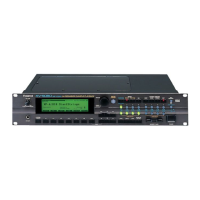17
Try Out the Sounds
6
After turning the VALUE dial to select the category, press [F6
(Select)] button to display the Patches in that category, in
groups of ten Patches.
7
By rotating the VALUE dial, move the cursor to the desired
Patch.
8
Press the VALUE dial (SOUND LIST) to return to the PATCH
PLAY page.
9
Press the [PATCH FINDER] button, extinguishing the
indicator.
In steps 4, 6 and 7, you
could also use the [INC]/
[DEC] buttons. or the
[ ]/[ ]/[ ]/[ ]
uttons.
In Pressing the [VOLUME]
knob (PHRASE PREVIEW)
allows you to audition the
selected Patch.
What is a Patch?
On the XV-5080, the basic unit of sound used in performances is called a
Patch. There are two types of Patches, Four-Tone Patches and Multi-Partial
Patches. A single Four-Tone Patch can be created by combining up to four
different tones. Although a Patch could consist of only a single tone, using
multiple tones allows you to create Patches with more complexity and
vividness. Not only can you get fat, rich sounds by layering sounds using
the internal Patches already available with the XV-5080 as is, you can also
enjoy a high degree of control in creating sounds, for example having
different tones sound depending on the range used, or the strength with
which the keys are played. Furthermore, the XV-5080’s parameters are
arranged in sets for even more effective management of elements used in
editing Patches, including the manner in which sounds are output, control
of the outputs, and effects processing.
Multi-Partial Patches are made up of constituent sounds called Partials,
which are assigned to a maximum of 88 keys and contain the settings for the
parameters needed for the performance. When loading S-700 Series Patches
to the XV-5080 from a CD-ROM or other source, these are automatically
treated as Multi-Partial Patches.

